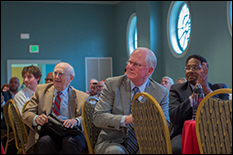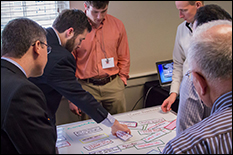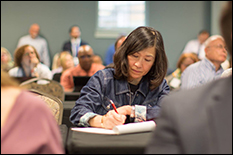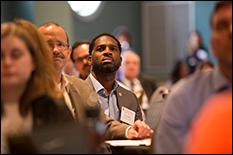|
The University of Maryland's third annual Project Management Symposium drew a record-breaking crowd May 12-13 as more than 260 project management professionals from the Baltimore-Washington region and areas around the world joined forces to tackle challenges impacting the field at large.
Held by the university’s Project Management Center for Excellence in College Park, Md., this year's event featured more than 70 esteemed speakers and keynotes covered topics ranging from project management methodology and disaster management to Building Information Modeling (BIM) and agile/IT.
New this year, Aviation Week Network sponsored the Aerospace and Defense Best Practices track in response to high demand for custom-made sessions that could touch on the specific challenges and opportunities project managers face in the aviation realm. Additionally, the Project Management Institute’s Government Relations Office in Washington, D.C., sponsored this year's federal programs track and a one-of-a-kind networking reception to wrap Day 1 of the event.
"One of the reasons our symposium is able to cover such a wide range of topics in project management year after year is because so many leading minds in the field come out for this event, willing and eager to share experiences and lessons learned with others in the industry," said John H. Cable, Director of UMD’s Project Management Center for Excellence.
To start things off, Bob McGannon of Mindavation discussed the importance of practicing "intelligent disobedience."
 "Intelligent disobedience, more often than not, is a means of protecting a business from itself," he said, explaining that, so often, project managers have a vision of what is happening within a given environment that a supervisor or company leader might not see. "The idea of intelligent disobedience is to be able to sift through that, enhance your own personal success in terms of how you can deliver a project, and ultimately, work with the nature of the businesses that employ you and [focus on] the ultimate business outcomes that they’re looking for. Finally, if we're doing this successfully as a set of colleagues in project management, [intelligent disobedience] will help this profession as well." "Intelligent disobedience, more often than not, is a means of protecting a business from itself," he said, explaining that, so often, project managers have a vision of what is happening within a given environment that a supervisor or company leader might not see. "The idea of intelligent disobedience is to be able to sift through that, enhance your own personal success in terms of how you can deliver a project, and ultimately, work with the nature of the businesses that employ you and [focus on] the ultimate business outcomes that they’re looking for. Finally, if we're doing this successfully as a set of colleagues in project management, [intelligent disobedience] will help this profession as well."
This message of elevating the field by demonstrating through collective success the impact project managers can have rang true throughout the two-day event.
Presenters such as Clark Construction Group's Catriona M. C. Winter showed how the company's role in developing the Wharf at Southwest Waterfront in Washington, D.C., centered on successful project execution and teamwork. She noted that it all began with the "formation of the best team to make sure we have the right cast of characters," and emphasized the importance of understanding the mechanics of leading such a team, right from the get-go.
"At the MITRE Corporation, we love complex problems that span multiple disciplines," said John Hall, Lead Human Factors Engineer with the MITRE Corporation in the Human Systems Integration, Visualization and Decision Support Department. Together with Brandy Weiss, Senior Human Centered Engineer in MITRE’s Collaboration and Social Computing Department, Hall co-led this year's interactive "Creative Collaboration for the Agile Process" session.
"Everybody has different interests, and there are a lot of different stakeholders to consider," he said. “How do you bring those stakeholders together?"
For MITRE, the methodology, known as the Agile Capability Mashup Environment (ACME), centers on an innovative tool developed to encourage team engagement and consensus building. Often, the proces involves three pieces: depth of knowledge, diversity, and a democratic model. And, the technique to fulfilling each of these areas is pretty straightforward, Hall said.
 In fact, for his team at MITRE, the piece centered on the "democratic model" often features a simple white board with a suspended web cam that allows everyone an equal chance to voice their opinions or ideas. In fact, for his team at MITRE, the piece centered on the "democratic model" often features a simple white board with a suspended web cam that allows everyone an equal chance to voice their opinions or ideas.
"So often, company leaders spend tons of money and resources around implementing technology, when what we really need is to get the technology out of the way," Hall said. "In order for agile to be executed successfully, individuals and teams with various skills sets need to communicate ideas, plan schedules, and collaborate solutions to potential problems."
Switching gears, Uma Hiremagalur, Vice President of Programs at the Washington, D.C. chapter of the Project Management Institute (PMI Washington), and Kendall Lott, CEO and President of M Powered Strategies, Inc., spoke about the importance of project management engagement in a different venue: volunteerism. In their session, "It's a Leadership Thing: Promoting PM Leadership through Volunteerism," the two talked about how volunteerism offers project managers an opportunity to be agents of change.
"The value is enormous – from the altruism of helping others, to problem-solving where others couldn’t, to helping some desperate need be met," Lott said.
"It's about really giving back how much you can give back and keeping your focus on what you want to get out of being a volunteer," Hiremagalur elaborated. "The work you do can be similar to your daily work, but volunteerism offers a unique opportunity to gain special experience and have fun. Volunteering is the perfect way to get comfortable working with people you don’t know to achieve something awesome. Working toward a common goal with others will help you appreciate diversity, develop mutual respect, and gain the cooperation needed to succeed."
And, in volunteering as "doers" and project leaders, project managers help further demonstrate the importance of the field at large, the duo noted.
Building on this concept, Laura Barnard, CEO and Founder of PMO Strategies, offered a riveting presentation on "helping those that help themselves” and creating effective and sustainable change for organizations.
"The project office exists to have an impact," she said, recognizing that there is a class of business leaders today who are hesitant to call their project support office a “project management office.” “They say, 'Whatever you do, don’t call it management.' This is an interesting trend, so I am trying to figure out why so many business leaders will call it anything but a 'PMO.'"
Barnard added that the best way to combat naysayers who claim that the concept of adopting a PMO is outdated is to demonstrate value by example.
"I say that if we have a positive impact, if we can show value, we will return the name 'PMO' or whatever you want others to call it to a place with which organizations and people want to operate," she said. "Why do we create PMOs in the first place? To get results, to align with strategy, to maximize business impact… It’s about identifying your priorities and, then, managing stakeholders. After that, we must perform relentlessly – it’s about getting results. We have to be okay and agile enough to shift when the needs of the organization shift. And then, we must communicate, communicate, communicate – but, with a purpose. Then, and only then, can we transform our own mindset and others’."
 Building further on the notion of understanding project management communication, Dr. Bill Brantley, Training Administrator for the U.S. Patent and Trademark Office's Global Intellectual Property Academy and an adjunct professor with UMD'ss Department of Civil and Environmental Engineering, conducted extensive analysis of 273 peer-reviewed journals to paint a detailed picture of what is being said and done to improve project management communication. Building further on the notion of understanding project management communication, Dr. Bill Brantley, Training Administrator for the U.S. Patent and Trademark Office's Global Intellectual Property Academy and an adjunct professor with UMD'ss Department of Civil and Environmental Engineering, conducted extensive analysis of 273 peer-reviewed journals to paint a detailed picture of what is being said and done to improve project management communication.
“Most of the time you hear about project management failures, it can be traced back to bad communication,” Brantley said. “If it’s not the top cause, it is almost always in the top-three.”
So often, bad communication can be linked to conflict or poor project execution. But, to shake things up a bit, Evan Piekara, Senior Consultant at BDO USA LLP, talked about the beauty of embracing conflict for one of this year's People in Projects sessions.
"Conflict occurs in any environment and the success of a project often depends on how leaders manage and resolve conflict," he said. "Issues can occur with various stakeholders – the project team, the client, and other influencers – and embracing problems head-on can be the difference between successfully completing a project and escalation that hinders productivity."
As such, Piekara outlined six main ways through which project managers can work to solve conflicts, and noted a variety of pros and cons for each. He added that there are ways to prepare a team for conflict – and they range from team-building activities as simple as happy hours or planned lunches to challenge events, during which teams have an open discussion about a problem and the junior members of the team are granted the opportunity to walk through solutions.
This concept of understanding that conflict and communications challenges arise in projects of all shapes and sizes was further echoed by Kenneth B. Sheely, Deputy Associate Administrator for Infrastructure for the National Nuclear Security Administration (NNSA). During his keynote presentation, "Applying Agile Development Techniques to Improve Program, Portfolio, and Enterprise Management," Sheely discussed the incredible challenges that come with safely operating and modernizing a nuclear security enterprise with more than $50 billion in real property assets and very tangible infrastructure and program concerns.
"In the past year, NNSA has applied agile techniques to deploy innovative, revolutionary processes and management tools to facilitate a data-driven process and enable risk-informed investment decisions," he said. "NNSA has also created a standardized, predictable, repeatable and transparent process and developed common vocabulary to improve communication between stakeholders."
But, he added, for organizations like NNSA that, for several decades, followed a stovepipe system of operation, it can be difficult to implement change.
 "Don't let perfect be the enemy of good," he advised. "You can make a lot of forward progress and what can result is this snowball effect. If you were describing a snowball to someone who had never seen one before, they would have no idea what you were talking about. To them, the world is flat, you’re going to fall off the edge if you do something. But, you have to try to take a risk. You have to start with that small snowball and then people will start getting behind you and help you push it to make it bigger and to help you make it into something more than you what you could make it by yourself." "Don't let perfect be the enemy of good," he advised. "You can make a lot of forward progress and what can result is this snowball effect. If you were describing a snowball to someone who had never seen one before, they would have no idea what you were talking about. To them, the world is flat, you’re going to fall off the edge if you do something. But, you have to try to take a risk. You have to start with that small snowball and then people will start getting behind you and help you push it to make it bigger and to help you make it into something more than you what you could make it by yourself."
Of course, project management challenges are not limited to the confines of buildings, nations, or even Earth, as some of this year’s speakers demonstrated.
To first drive home the unique scenarios project managers encounter when dealing with transnational projects and stakeholders, Dr. Aurangzeb Zulfiqar Khan, an assistant professor in the Department of Management Sciences at the COMSATS Institute of Information Technology in Islamabad, Pakistan, defined what makes such projects unique.
Noting that transnational projects involve entities from two or more states providing significant project input, he said that, most often when one thinks of transnational projects, he or she thinks of big infrastructure schemes or oil pipelines that transcend national borders.
"But, there are many transnational projects that do not physically transcend national borders," Khan said. "Instead, they take place within the confines of one state but are still transnational in character."
The benefits of working across physical dividing lines are plentiful: they enable the pooling of different types of resources, such as financial, technological, or managerial resources. They also enable access to a diverse spectrum of experiences, ideas, strategies, processes, quality standards, and work methods, he said.
The concept of pooling resources is something very familiar to Dr. W. Michael Hawes, Vice President and Orion Program Manager for Lockheed Martin Space Systems Company, but often for different reasons.
Hawes, one of this year's keynote speakers, knows all too well the project management challenges that one encounters when working beyond both national boundaries and the ultimate physical boundary: Earth's atmosphere.
Hawes joined Lockheed Martin in July 2011 after concluding a 33-year career with NASA, where he served as the Associate Administrator for Independent Program and Cost Evaluation, and the Deputy Associate Administrator for Program Integration in the Office of Space Operations at NASA Headquarters. He also served as the Deputy Associate Administrator, International Space Station (ISS) and Program Director for the ISS at NASA Headquarters.
"The relationships and communications are really critical [to success]," he said. "As much as I want to believe – and perhaps, my kids' generation will have it better – the electronic tools are not enough. We still need people-based connections to be able to build relationships."
He noted that this is a challenge, especially given NASA’s budget constraints.
 "There are folks in the space world who remember the days of Apollo, but that doesn't happen anymore. NASA is no longer six percent of the federal budget – NASA is 0.5 percent of the federal budget, and it still has a portfolio that covers all the planetary missions, all the human space flight missions, aeronautics, earth-sensing and other space science machines... That means, everything is driven by affordability – and that's a challenge all of you face in project management. To [meet affordability], we did not go forward to bring everyone together. Instead, I work with folks who are in six different locations, and other teams likely work with people across even more locations.” "There are folks in the space world who remember the days of Apollo, but that doesn't happen anymore. NASA is no longer six percent of the federal budget – NASA is 0.5 percent of the federal budget, and it still has a portfolio that covers all the planetary missions, all the human space flight missions, aeronautics, earth-sensing and other space science machines... That means, everything is driven by affordability – and that's a challenge all of you face in project management. To [meet affordability], we did not go forward to bring everyone together. Instead, I work with folks who are in six different locations, and other teams likely work with people across even more locations.”
Nevertheless, Hawes drove home the idea that project managers must be forward-thinking, and must continue to understand the value of relationships that support success.
Recognizing also how connections help promote the field of project management at large, Dr. Darryll Pines, University of Maryland A. James Clark School of Engineering Dean and Nariman Farvardin Professor, shared how the university’s Project Management Center for Excellence aims to foster connections between project managers across industry, government, and academe.
"In the same way that many men and women in this room today represent varied backgrounds and areas of expertise, the students enrolled in our Project Management program come from a wide range of STEM fields," he told symposium attendees. "In fact, 80 percent of the center's graduate students are from technical backgrounds other than civil engineering, including information technology, mechanical engineering, fire protection engineering, and electrical engineering."
The Project Management Center for Excellence proudly thanks this year's symposium sponsor, The Whiting-Turner Contracting Company, for its support.
Next year's University of Maryland Project Management Symposium is slated for May 4-5, 2017 on the University of Maryland campus in College Park, Md. Paper submissions will be accepted beginning September 2016.
Related Articles:
Coming Together in the Name of Project Management
UMD Project Management Symposium Early-Bird Deadline Wednesday, April 15
Cable Selected for NAE’s Sixth Frontiers of Engineering Education Symposium
UMD to Lead Citizen Developer Training for edX
Project Management Center for Excellence Lauded by Accreditor
Flipping the Classroom in Engineering and Project Management
Glodon Software Gift to Support Advancements in Smart Construction
Cable, Symposium Speakers Featured in Project Management Podcast
Masters of Engineering Student Shares Expertise at Project Management Day of Service
University of Maryland to Host Fourth Annual Project Management Day of Service
May 19, 2016
|

